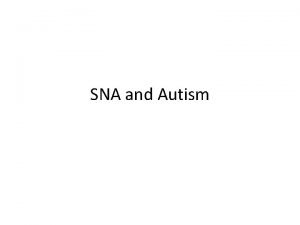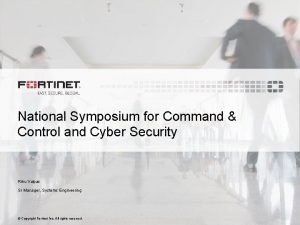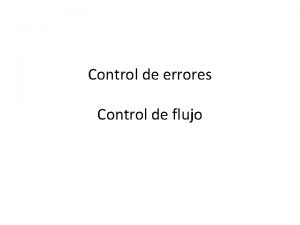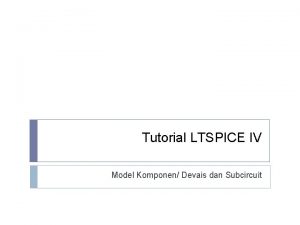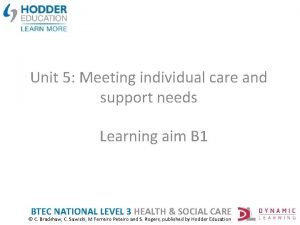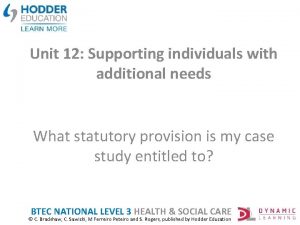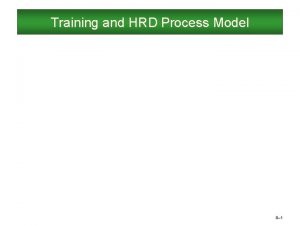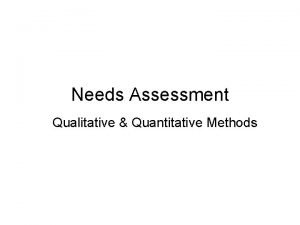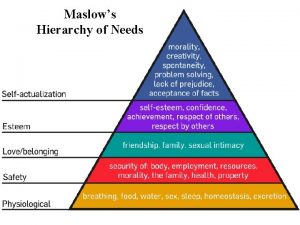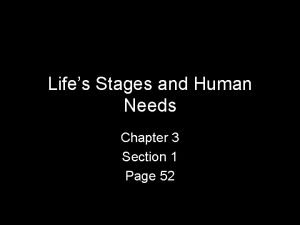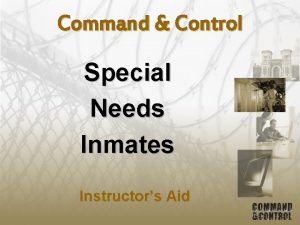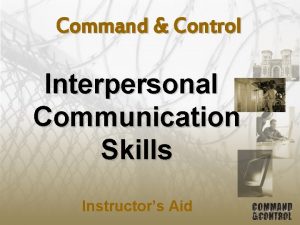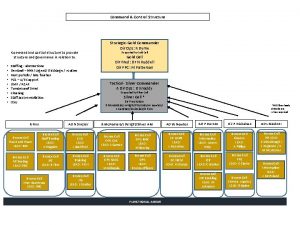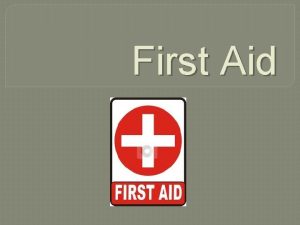Command Control Special Needs Inmates Instructors Aid Command













































































































- Slides: 109

Command & Control Special Needs Inmates Instructor’s Aid

Command & Control Program Objectives §Definition of Special Needs §How to Identify and Manage Inmates with Mental Disabilities

Command & Control § How to Identify and Manage Inmates with Personality Disorders § How to Manage Inmates with Physical Disabilities

Command & Control Special Needs Inmates is designed to instruct corrections and detention officers in the basics concepts of identifying and managing special needs inmates.

Command & Control A Definition What is a Special Needs Inmate? A Special Needs Inmate has a physical or mental disability that limits his or her capacity to function in the normal inmate population.

Command & Control Notice the definition does not say “special inmates. ” It does say, “inmates with special needs.

Command & Control Never forget the fact that these are people who are incarcerated for a reason. Inmates are suspected or convicted criminals. They have physical or mental limitations that require special attention and consideration.

Command & Control Mental Disabilities You will encounter some special needs inmates with mental disabilities. They will behave differently than other inmates, sometimes in strange and unpredictable ways.

Command & Control Mental disabilities can be subdivided into three general categories: § Developmental Disabilities § Learning Disabilities § Mental Illness

Command & Control Individuals with developmental disabilities are often referred to as mentally retarded. This means their measured intelligence quotient, or IQ, is significantly below the norm of 100.

Command & Control Levels of mental retardation are: Mild IQ 51 -69 Moderate IQ 35 -50 Severe IQ 20 -35 Profound IQ < 20

Command & Control An individual is considered Mildly retarded if their IQ is measured between 51 and 69, Moderately retarded if their IQ is between 35 and 50, Severely retarded between 20 and 35, and Profoundly below 20.

Command & Control Courts most usually place Moderately, Severely, or Profoundly retarded offenders in institutions that have the resources to care for them.

Command & Control You are most likely to encounter the developmentally disabled offenders who are mildly retarded.

Command & Control Mental Retardation At first the behavior of the offender who is mildly retarded may seem almost normal, or described by others as “a little slow. ”

Command & Control But there are ways to recognize mental retardation. Some signs are: § Lack of judgment in personal hygiene. They may forget to shower or comb their hair or brush their teeth.

Command & Control § Difficulty Communicating Retarded offenders may not be able to make themselves understood by officers or other inmates because their thinking is not logical.

Command & Control § Unusual or inappropriate social behavior Retarded offenders may think some things are funny when no one else does, or make inappropriate comments during someone’s conversation.

Command & Control § Lacking in basic life skills They will have trouble with things such as balancing their commissary account, or knowing how to make a collect call.

Command & Control These are only signs of mental retardation, none is conclusive proof. If you suspect an inmate is mentally retarded and has not been identified during intake or booking, refer them to a mental health professional for evaluation.

Command & Control Managing Mentally Retarded Inmates Retarded people have difficulty functioning in a variety of situations, especially ones that are new to them.

Command & Control They may seem confused about what to do and how to act. Have difficulty learning new things to the point where you may think they are being defiant or noncompliant.

Command & Control It is your job to be alert. This kind of behavior is easy to misread in a corrections setting.

Command & Control It is important to remember the difficulty the retarded inmate is experiencing is not something he or she can control.

Command & Control It is a result of deficits in adaptive behavior. To overcome these deficits, use straightforward communication techniques.

Command & Control Communicating With Mildly Retarded Inmates § Give specific and concrete directions. § Use simple, direct language.

Command & Control § Use small, sequential steps. § Check to see that directions are followed. Be specific with your directions.

Command & Control Do not give abstract directions like: “Clean this place up. ” Be specific: “Fill this bucket with water and use this mop to wash the floor. ”

Command & Control Be specific and patient. Continue to use specific, concrete instructions.

Command & Control Protecting Retarded Inmates Mentally retarded offenders may be easily manipulated or abused by other inmates because they are sometimes highly impressionable and eager to please.

Command & Control It’s not only your job to protect the retarded inmate from physical, sexual, and emotional abuse… …but to make sure other inmates don’t talk them into hiding contraband, assaulting officers, or engaging in illegal behavior.

Command & Control Learning Disabilities These inmates may have normal or above average intelligence, but have difficulty understanding or using language, either written or spoken.

Command & Control They will most likely have problems with listening, speaking, reading, writing, mathematics, or logical thinking.

Command & Control Many people with learning disabilities try to compensate with excuses or other behavior that may make detection difficult.

Command & Control Learning disabilities cover a wide spectrum of symptoms and severity. Some individuals may appear very bright, while others may seem very slow.

Command & Control Helping Inmates with Learning Disabilities If you should encounter inmates with learning disabilities you can help them by…

Command & Control Making sure they get the information they need. Make sure the learning disabled inmate gets the information they need to succeed in the institution. This may mean helping them read documents

Command & Control Give directions slowly and clearly; demonstrate. Give all directions slow and clear. Demonstrate the behavior or activity. Ask the inmate questions until you are sure they understand.

Command & Control Offer assistance but promote independence. An example, you might help them solve a math problem rather than doing it for them.

Command & Control Protect learning disabled inmates. Protect them from other inmates who may take advantage of their limitations.

Command & Control Be understanding. The most important thing you can do for anyone with a learning disability is to be understanding and supportive.

Command & Control Encourage the inmates efforts at independence. Offer them help of specially trained staff members who know how to assist them. Above all, TREAT them with the same dignity and respect you would give anyone else.

Command & Control Mental Illness – Emotional Disturbances. You may encounter an inmate with mental illness. There are many classifications of mental illness. We will discuss two major categories.

Command & Control § Emotional Disturbances and § Personality Disorders

Command & Control Emotional Disturbances People with emotional disturbances often suffer from defects in their brain chemistry that can cause unpredictable, sometimes bizarre behavior.

Command & Control The inmate can appear to function normally, often for great lengths of time. Be alert to indications of emotional disturbances. Emotional disturbances usually reveal themselves relatively slowly.

Command & Control The following are a few signs of emotional disturbance.

Command & Control Mood Changes Prolonged mood shifts result in major changes in behavior.

Command & Control Behavior Changes When behaviors become aggressive, violent, or strange, the inmate is often referred to as “acting out. ”

Command & Control Changes in eating or sleeping pattern Mental illness can affect the body’s physiology. The mentally ill inmate can begin skipping meals and losing weight.

Command & Control Many inmates will exhibit some of these behaviors some of the time. What you need to look for are significant, prolonged changes in behavior patterns that are unrelated to other events.

Command & Control While there are many kinds of mental illness, ones you are most likely to encounter are: Schizophrenia, Anxiety Disorders, Paranoia, Hypochondria, and Depression.

Command & Control Schizophrenia People with schizophrenia are usually out of touch with reality. Schizophrenics may exhibit some of the following symptoms:

Command & Control They may have irrational thoughts, speak in bizarre and disorganized ways – making up words or talking to themselves incoherently.

Command & Control Schizophrenics may also experience delusions, like they are being spied upon…. …exhibit bizarre actions, such as strange rituals, like starring at their own hands, or wearing their clothing inappropriately.

Command & Control Finally, they may have hallucinations; hearing voices, or seeing things that are not there.

Command & Control Medication can often control schizophrenia, making it possible to join the general population when they behave normally.

Command & Control Inmates with “active schizophrenia” can be dangerous because they are out of touch with reality. You must be alert to these symptoms, and, if necessary isolate the inmate and get help from mental professionals immediately.

Command & Control Anxiety Disorders The next mental illness you may encounter is likely to be anxiety disorders. People who suffer from this disorder are excessively anxious for long periods of time.

Command & Control They may exhibit symptoms of excitability, muscle tension, sweating, rapid heart beat, and sometimes dizziness. Severe anxiety can usually be treated with tranquilizers. Remember, these medications can become addictive, use should be tightly controlled.

Command & Control Another illness you may encounter is “paranoia. ” People with paranoid personality disorder are excessively distrustful and suspicious of others.

Command & Control Paranoid people read hidden threats into normal remarks or incidents. They bear grudges and are unforgiving of insults or injuries. They fear others will share information about them, and worry about the loyalty of friends.

Command & Control One thing to remember, in a prison or jail setting, paranoid behavior is not uncommon. If an inmate complains that other inmates are threatening him or her, don’t deny the inmate’s feelings or reject the claim.

Command & Control Always ask questions to get more facts… … and then report the threat to your supervisor.

Command & Control Hypochondria is an exaggerated concern over one’s physical health. Simply stated, hypochondriacs believe they are sick most of the time.

Command & Control You must always take every inmate’s medical complaints seriously. This may be difficult because hypochondriacs often complain constantly and insist on visiting the medical unit almost every day.

Command & Control Denying access to medical care may put you at risk of being sued for jeopardizing an inmate’s well-being. So, if you feel there is no justification for it, you should refer all medical complaints to the medical staff for evaluation.

Command & Control Depression The final, and probably the most common illness you are likely to encounter is depression.

Command & Control More than just sadness, depression is also a chronic feeling of hopelessness, or self-loathing. Symptoms include; apathy, loss of appetite, changes in sleep patterns and anti-social behavior.

Command & Control Depression can usually be treated with medication and counseling. However, left untreated, it is a real danger to the inmate and can lead to suicide attempts.

Command & Control Suicidal inmates may have other symptoms like extreme self pity. They may talk about suicide, leave suicide notes, give away their possessions, followed by a period of calmness that suggests they have decide to commit suicide.

Command & Control Some suicide threats are trial runs for the real thing. Take all threats or gestures seriously. Report them to the mental health professionals on staff.

Command & Control Managing Mentally Ill Inmates There are specific things to keep in mind to effectively manage inmates with all types of mental illness.

Command & Control To remember, think “S-S-P” § Sick, not bad § Symptoms are real § Positive & professional

Command & Control First, remember the mentally ill person is a sick person, not a bad person. You may become frustrated with the inmates behavior and angry that they won’t “just shape up. ”

Command & Control Treat the mentally ill inmate with the same patience you would have for someone with a physical illness.

Command & Control Second, you should recognize to the mentally ill, their symptoms are very real, even if they may seem preposterous to you. Do not support the delusion, but understand the inmate’s feelings are genuine.

Command & Control Third, you should stay positive and professional. Emotionally disturbed people take cues from those around them. So it pays to be calm and upbeat.

Command & Control Do not take bizarre behavior personally. Your own emotional wellbeing should remain professionally detached, refer mentally ill inmates to the mental health staff.

Command & Control Mental Illness – Personality Disorders People with personality disorders do not play by the rules, but want their own rules.

Command & Control They are impulsive, usually without regard to the consequences of their behavior. Often they are compulsive liars, and do it with sincerity and without guilt.

Command & Control They do not learn from experience, have disregard or even contempt for authority. Often they have trouble with relationships, are irresponsible, and unreliable, insisting on immediate gratification, rather than long-term goals or commitments.

Command & Control People with personality disorders are prime candidates for run-ins with the law, so it is not unusual to find them in a correctional setting.

Command & Control Because they do not have a conscience, they can be very dangerous. Dealing with inmates with personality disorders means you must be straightforward and factual.

Command & Control Enforce the rules consistently. Get help from mental health professionals when needed.

Command & Control Physical Disabilities What You Should Do These will include people who are deaf or blind, diabetes, paraplegia, and epilepsy.

Command & Control Most corrections professionals are not experts in American Sign Language. Therefore, to communicate with the deaf inmate it is usually done in writing. Always have pen and paper on hand.

Command & Control To get a deaf person’s attention, tap them on their shoulder, but do so with caution, not to startle the inmate. If the deaf person can read lips, speak slowly, clear, and in a normal tone of voice.

Command & Control Blind inmates are becoming more common. You must familiarize the blind inmate with the living area to prevent injuries. Consider posting a sign on the inmates cell alerting staff members to the disability.

Command & Control When offering assistance, allow the inmate to take your arm for guidance. To greet a blind person, identify yourself and others, let the blind person know the conversation is over and you are moving away.

Command & Control With diabetes, the pancreas does not produce enough insulin needed for normal blood sugar metabolism. Controlling diabetes usually includes insulin doses and a regulated diet.

Command & Control Diabetics are subject to two life threatening conditions that you should be aware of: Ø Diabetic Coma Ø Insulin Shock

Command & Control Diabetic Coma Diabetic coma, or hyperglycemia is a result of not enough insulin in the bloodstream. Caused by an overdose of medicine, not eating enough, or over-exercising.

Command & Control Symptoms include; lightheadedness, sweating, trembling, hunger, and weakness. This condition can develop very quickly and the person needs sugar immediately in any form, along with medical attention.

Command & Control Word of caution: Symptoms of both diabetic coma and insulin shock are similar to alcoholic intoxication. If the diabetic does not get immediate medical attention, brain damage or death could result.

Command & Control Paraplegia When you encounter an inmate who is wheelchairbound, do not make an issue out of the disability.

Command & Control Treat them as you would any other inmate, especially with regard to rules, regulations and privileges.

Command & Control Leaning on a person’s wheelchair is similar to hanging or leaning on their body. The chair is part of the inmate’s body space, so treat it as such.

Command & Control If you have to speak at length to someone in a wheelchair, position yourself to the disabled person’s level.

Command & Control Epilepsy is a malfunction of the electrical system of the brain that results in seizures.

Command & Control The most severe type of seizures, the victim suddenly loses consciousness, becomes rigid and falls. They may have convulsions, foam at the mouth, jerk uncontrollably, or even stop breathing temporarily.

Command & Control These are called grand mall seizures and usually last two to three minutes.

Command & Control When you encounter an inmate having a seizure, you should: Remove all nearby objects that could cause injury. Remove eyeglasses, loosen tight clothing.

Command & Control Turn the person to the side; keeping airway open. And, put a pillow or folded blanket under the inmate’s head.

Command & Control Do not attempt to restrain the inmate unless he is in a dangerous place that could cause injury. Do not put objects in the inmate’s mouth. Contrary to belief, people cannot “swallow” their tongue.

Command & Control Call for medical assistance immediately, call for backup to keep the area secure.

Command & Control Remember In all cases of disabilities, the important thing is to remain professional.

Command & Control Always document any unusual occurrence. These are not special inmates… … but inmates with special needs.

Command & Control QUESTIONS Instructor’s Aid
 Dale cone of experience
Dale cone of experience Lpso inmate
Lpso inmate Warren county ky jail commissary
Warren county ky jail commissary Lpcc inmates
Lpcc inmates Siskiyou county jail bookings
Siskiyou county jail bookings Famous san quentin prisoners
Famous san quentin prisoners Broadmoor patients
Broadmoor patients Primary needs and secondary needs
Primary needs and secondary needs Primary needs and secondary needs
Primary needs and secondary needs Henry murray theory
Henry murray theory Strategic gender needs and practical gender needs
Strategic gender needs and practical gender needs Target needs in esp
Target needs in esp First aid merit badge first aid kit
First aid merit badge first aid kit Neasden medical centre
Neasden medical centre Project based learning for students with special needs
Project based learning for students with special needs Elderplan plan materials
Elderplan plan materials Teachwise app
Teachwise app Special educational needs and disability act 2001
Special educational needs and disability act 2001 Friends of children with special needs
Friends of children with special needs Special needs trust virginia
Special needs trust virginia Special needs trusts colorado
Special needs trusts colorado Instructional adaptations for special needs students
Instructional adaptations for special needs students Castlewood primary school
Castlewood primary school Role of sna with autism
Role of sna with autism European agency for development in special needs education
European agency for development in special needs education Safpf dallas county
Safpf dallas county Safeguarding special needs
Safeguarding special needs Pervent
Pervent Open source command and control software
Open source command and control software Cyber security command and control
Cyber security command and control Scuml meaning
Scuml meaning Strategic surveillance control
Strategic surveillance control Translational research institute on pain in later life
Translational research institute on pain in later life Difference between process control and product control
Difference between process control and product control Reynold’s transport theorem
Reynold’s transport theorem Stock control e flow control
Stock control e flow control Control volume vs control surface
Control volume vs control surface Lac operon positive control
Lac operon positive control Negative control
Negative control Data link control
Data link control Control de errores
Control de errores Negative control vs positive control examples
Negative control vs positive control examples Flow control and error control
Flow control and error control Sectional drive
Sectional drive Salin teks di foto
Salin teks di foto Home republic myer
Home republic myer Personality pyramid
Personality pyramid Conservation of mechanical energy examples
Conservation of mechanical energy examples Brandi needs her protein
Brandi needs her protein Glasser 5 basic needs
Glasser 5 basic needs What are wants
What are wants Taba's curriculum model
Taba's curriculum model Basic human needs list
Basic human needs list Difference between need and want
Difference between need and want Wants and needs analysis
Wants and needs analysis Henderson 14 basic needs
Henderson 14 basic needs Virginia henderson 14 activities
Virginia henderson 14 activities Henderson 14 basic needs
Henderson 14 basic needs Unit 5: meeting individual care and support needs
Unit 5: meeting individual care and support needs Chapter 14:3 observing fire saftey
Chapter 14:3 observing fire saftey Unit 18 assessing children's development support needs p1
Unit 18 assessing children's development support needs p1 Supporting individuals with additional needs
Supporting individuals with additional needs Hrd process
Hrd process Materials and tools in making electrical gadgets
Materials and tools in making electrical gadgets Tomorrow needs us song
Tomorrow needs us song Secondary needs
Secondary needs Human needs theory of aging
Human needs theory of aging Adult needs and strengths assessment
Adult needs and strengths assessment Piramide de erikson
Piramide de erikson It fulfills the spiritual needs of a culture.
It fulfills the spiritual needs of a culture. Social emotional needs of ell students
Social emotional needs of ell students William schutz interpersonal needs
William schutz interpersonal needs Jenny needs to ask me. i will buy it for her
Jenny needs to ask me. i will buy it for her Message authentication code
Message authentication code Satisfying needs
Satisfying needs Right basic needs
Right basic needs Recruitment policy meaning
Recruitment policy meaning Psychological approach in literature
Psychological approach in literature Project integration management
Project integration management Mention the significance of project formulation
Mention the significance of project formulation Henderson 14 basic needs
Henderson 14 basic needs Needs and wants in entrepreneurship
Needs and wants in entrepreneurship Ade needs assessment
Ade needs assessment Quantitative and qualitative difference
Quantitative and qualitative difference Necessities lacks and wants
Necessities lacks and wants The detective need more time to inquire about the case
The detective need more time to inquire about the case Abraham maslow hierarchy of needs summary
Abraham maslow hierarchy of needs summary Security needs examples
Security needs examples Individual needs examples
Individual needs examples Maslow’s theory maintains that
Maslow’s theory maintains that Maslow beliefs
Maslow beliefs Needs wants and demands
Needs wants and demands El marketing management
El marketing management Manpower inventory meaning
Manpower inventory meaning 7 basic human needs for survival
7 basic human needs for survival Satisfying needs chapter 6
Satisfying needs chapter 6 Bradshaw mercer social needs
Bradshaw mercer social needs Lnm matrix canvas
Lnm matrix canvas Customer need adalah
Customer need adalah The neurotic need for affection and approval
The neurotic need for affection and approval Internal and external issues template
Internal and external issues template Scope of human relations
Scope of human relations Includes the individual and the family community is
Includes the individual and the family community is Human needs model
Human needs model Glasser's basic needs
Glasser's basic needs Fire needs 3 things
Fire needs 3 things Fire needs 3 things
Fire needs 3 things Values needs and wants
Values needs and wants Needs and wants
Needs and wants Saviour he can move the mountains
Saviour he can move the mountains























